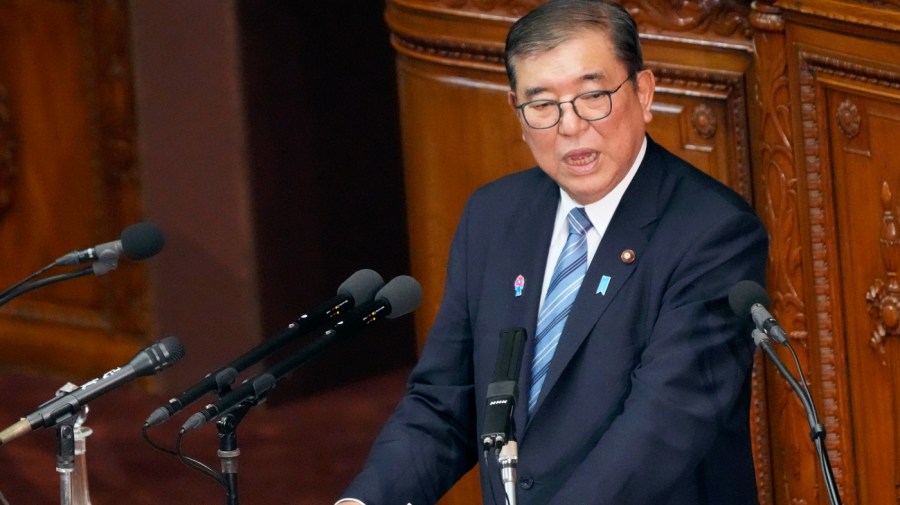
Can Japan assert its own national interests while promoting itself as a staunch ally of the U.S.? That will be the challenge for Japanese Prime Minister Shigeru Ishiba when he meets with President Trump in Washington later this week.
When Trump was elected the first time around, the late Premier Shinzo Abe was the first world leader to visit the incoming president at Trump Tower, bearing a gift of golden golf clubs. Eight years later, it will take far more than a charm offensive, and the price tag of Japan’s gifts to the U.S. will be far heftier.
The question is whether the cost to be borne by Tokyo will pay off in the end.
Ishiba will no doubt emphasize Japan’s continued steady investments in the U.S. over the decades and promote Japan as a strategic investor in U.S. advanced technology and manufacturing. According to the Bureau of Economic Analysis , the U.S. was the world’s top destination for foreign direct investment in 2023. Japan was its single biggest investor in providing over $783 billion that year, mostly in the manufacturing sector.
What’s more, Japanese tech giant Softbank’s CEO Masayoshi Son personally told Trump that his company would invest up to $100 billion in the U.S. before announcing that Softbank together with OpenAI and Oracle would spend at least $500 billion for their Stargate Project to develop AI infrastructure in the country.
The prime minister is expected to make a pitch for Japan as a critical partner to make America even greater. While Trump may zero in on the continued U.S. trade deficit with Japan — it reached $68 billion, driven largely by the auto sector — Ishiba will most likely point out the steady rise of U.S. exports to Japan and even greater prospects for Japan to import from the U.S., especially in the energy sector.
As Washington looks to bolster its standing as an energy exporter, Japan will be an eager client as it looks to continue decreasing energy dependence from the Middle East as well as Russia. It is widely expected that Japan, one of the world’s biggest importers of liquefied natural gas, will be importing more gas from the U.S., which has emerged as the world’s biggest exporter of the fuel.
There is speculation too that Ishiba could offer to support developing an 800-mile Alaskan gas pipeline that could lead to an export boom from the state for $44 billion. The pipeline may not necessarily be financially viable, but it would be seen as a strategic move to curry Trump’s favor.
Back in Tokyo, the success of Ishiba’s Washington visit will undoubtedly be measured in part by whether he will be able to keep Japan from being targeted by U.S. tariffs and avoid being in the line of fire like Canada and Mexico.
But that’s not all. The impasse over Nippon Steel’s $14.1 billion bid to acquire U.S. Steel remains a thorn in bilateral relations after President Joe Biden blocked the deal citing national security concerns. Together, Nippon Steel and U.S. Steel have sought to overturn the ruling, even as Trump too has publicly voiced his opposition to the deal, arguing the need to keep the steel industry under U.S. ownership.
Nevertheless, there are glimmers of cautious optimism in Japan following U.S. Steel’s latest poor financial performance as the Pittsburgh-based company recently reported a net loss of $89 billion in its latest quarter. The Japanese hope is to appeal to Trump’s instinct to make a deal that would revitalize the U.S. steelmaker as China continues to dominate the global steelmaking industry, even as most analysts acknowledge the political challenges within the United States that could quash the deal once and for all.
During the first Trump administration, Japan succeeded in securing U.S. buy-in to the concept of developing an Indo-Pacific strategy and developing a network of nations with shared concerns about China’s disregard for the rule of law and abuse of its economic might for political gain.
Ishiba’s challenge will be first and foremost to promote Japan as an ally that shares Trump’s goal to bolster greater U.S. economic resilience and competitiveness. At the same time, the prime minister will need to defend Japan’s own strategic economic interests as he seeks to lay the groundwork for U.S.-Japan economic relations over the next four years.
Should he be successful in staving off U.S. tariffs against Japanese imports, his strategy is likely to be closely studied and emulated across advanced economies. But Ishiba should also not lose sight of Japan’s role in promoting the U.S. as an Indo-Pacific power.
The Japanese prime minister will be tested on whether he can make a case for the effectiveness of strength in numbers of partners in meeting the China challenge and argue that U.S. power can be multiplied through cooperation with like-minded governments.
Shihoko Goto is the director of the Indo-Pacific Program at the Wilson Center.









